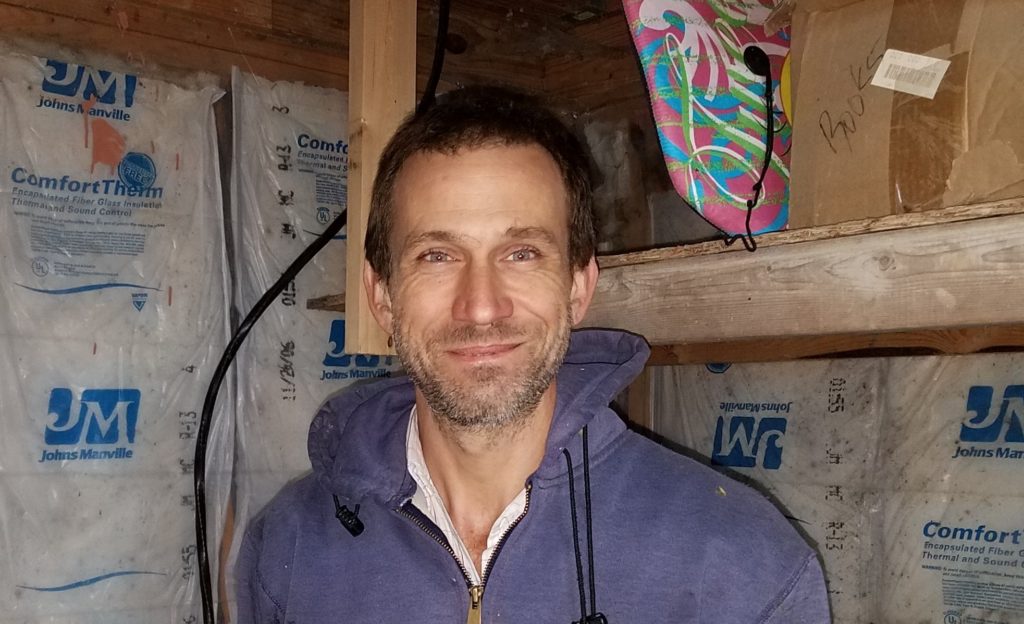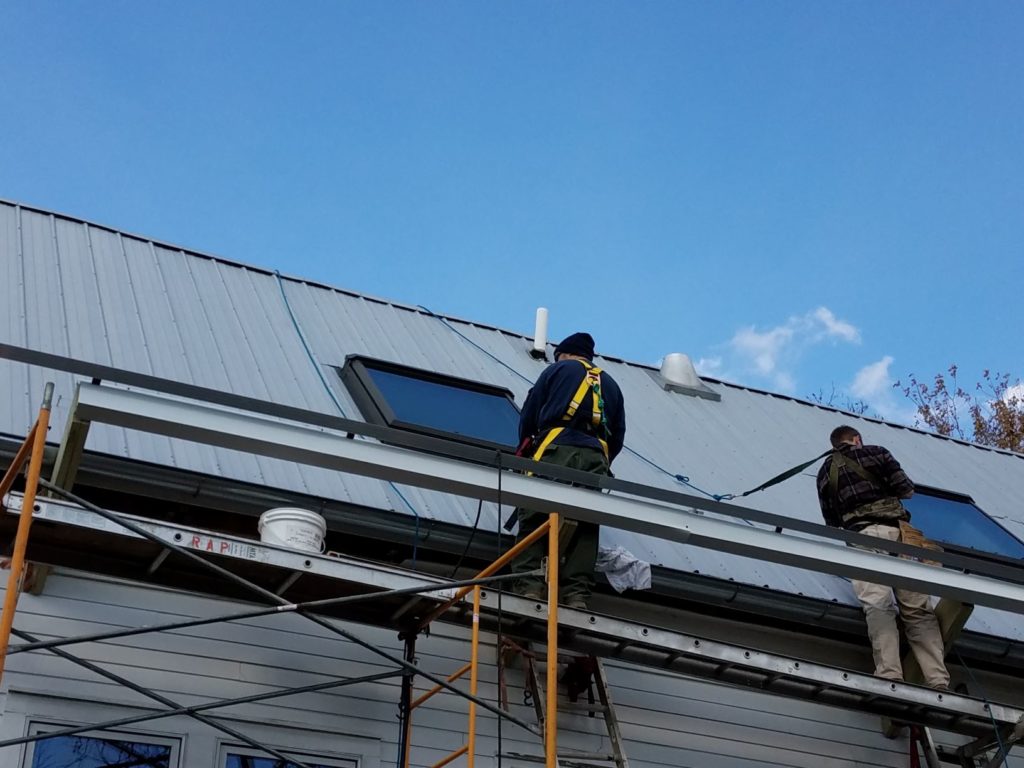Greg Deemer and Stacey Decker have been working on energy efficiency improvements ever since Greg did a gut rehab of their old farmhouse in 2003. The foundation walls are a foot thick with insulation to prevent heat loss. In warm winters, the house is sometimes warm enough just from cooking and letting the sun in through south-facing windows and skylights. Greg has laid radiant heating coils under a concrete slab with 2” foam in the basement workroom floor and is planning to get a tankless water heater. As conscientious stewards of the land, the couple really wanted to get solar panels so they could break their dependence of fossil fuels to make electricity. With a grant from Indiana Solar for All, they got their system in the fall of 2018.

“Our house is the most challenging installation of any that we did this fall just because the panels are being installed 20 feet off the ground, and we have a very steep metal roof with skylights that were in the way of placing the panels on the roof across the back,” Greg Deemer said.
Greg was the roof lead for the other three fall installations because he had professional experience as a residential builder. That professionalism showed in the solution he came up with for his own installation. He designed and built an awning, anchored right under the eaves, to support the panels. The awning supports the rails, eliminating the need to penetrate the metal roofing. It solved another problem as well. The south-facing windows have always gotten too much sun in the summertime so the awning will provide needed shade in the summer.
“But we didn’t want an awning coming all the way out because the 5 1/2 foot panels would have taken away too much of our winter sun so we put the awning half on the roof and half off. That was kind of challenging,” Greg said. It involved calculating the angle of the sun in both seasons, the degree of tilt for the panels and the length of the overhang before he could build the awning. “It made me think about it for a couple months while I was trying to get it together. Then I got it together the week before the install.”
For the installation, Greg borrowed scaffolding from a friend. A walkboard laid down on a ladder bridging the two scaffolds provided a walkway for him and the other two members of the roof crew, Brent Hutchinson and Clarence Knapp. They wore safety harnesses and ropes to ensure their safety as they moved along the walkway putting the rails, and later the panels, in place. Other volunteers lifted the panels from the ground to people standing on the scaffold as they were needed.

Greg said, “It worked good. Maybe it looked funny from the ground. Basically I was laying on my back on the walkboard underneath the panel and holding the panel in place while someone else was tightening the bolts from above. Clarence took a turn at it too. Then from where we were, we were able to hook up the wiring from the optimizers underneath after the panel was in place. That was different than on the other roofs where we had to hold the panel up, hook it up, and then set it down into place. So our optimizers are always going to be accessible, which is different, so if we ever have one of them go bad, then we can get up there and replace it without removing the panel.”
How it came together
This installation took a day and a half. On Saturday, the ground crew, led by Woodie Bessler, installed the inverter in the basement, prepared the connections to the breaker panel in the kitchen, and laid the ethernet cabling that enables the inverter to report on the system’s performance. Meanwhile, the roof crew attached the bottom rail, most of the top rail, and a few panels to the awning. After the volunteers went home, Greg and Stacey (the ISFA volunteer coordinator) finished up the top rail and set the optimizers in place, working right up until dark – and a little after.
Stacey said, “Getting the optimizers up that first night was just a really good idea because that’s when we worked out our system for how to move the last panels up and into place. The added height meant everything just took a little bit longer than the previous installs.” Greg added, “It was the fourth install in four weekends, so we wanted to make sure that everything got finished on Sunday. And there was a threat of rain Sunday afternoon that kept us moving too.”
On Sunday, all the panels were set in place and plugged into the junction box. Paul Leber, the ground lead that day, bent conduit, pulled cable through it and tied the cable into the inverter in the basement and the disconnect switch on the safety box on the outside wall. An hour after lunch, 30 minutes before the rain came, the job was done.
Lessons learned
Stacey said, “Brent and Clarence were really great on the roof. They didn’t seem to have a lot of fear being up there. It was so helpful to have three people who felt very steady. The rest of us could think about getting up there when it felt comfortable and what it would be good for us to do while we were up there. It’s interesting being up high. You just have to get your footing and realize that you are alright. I felt like the whole time, everybody was being very cautious and safe. It was exciting for me because I didn’t get to help physically with any of the other three jobs, so this was fun to actually be part of.”
Greg added, “I was wary of volunteer building projects when I started this. I’ve seen some in the past, have been in charge of one, and this was just a different experience completely. Everybody was so committed to getting it done and working together and we didn’t really have people who were unable to listen or unable to contribute as needed. It was very good.”
Greg praised the training that the volunteers received from Ryan Zaricki of Whole Sun Designs, the project consultant, for their success. “I was kind of amazed. Most people seemed like they had basic mechanical skills when they started but they rapidly gained the skills they need for installation. Also the whole solar system is so well engineered to go together easily; as Ryan said, it’s like Tinker Toys for adults. That was really good,” he concluded.
The Deemers have a deep connection with sunlight that goes beyond solar panels. The family has a greenhouse and three acres under cultivation, operating as Stanford Farm. Greg sells at the farmer’s market in Bloomington and Nashville. Check their Facebook page, to see more about the farm.
